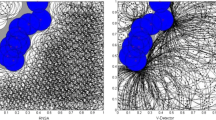Abstract
Negative selection algorithm (NSA) is an important method of generating artificial immune detectors. However, the traditional NSAs aim at eliminating the self-recognized invalid detectors, by matching candidate detectors with the whole self set. The matching process results in extremely low generation efficiency and significantly limits the application of NSAs. In this paper, an improved NSA called CB-RNSA, which is based on the hierarchical clustering of self set, is proposed. In CB-RNSA, the self data is first preprocessed by hierarchical clustering, and then replaced by the self cluster centers to match with candidate detectors in order to reduce the distance calculation cost. During the detector generation process, the candidate detectors are restricted to the lower coverage space to reduce the detector redundancy. In the paper, probabilistic analysis is performed on non-self coverage of detectors. Accordingly, termination condition of the detector generation procedure in CB-RNSA is given. It is more reasonable than that of traditional NSAs, which are based on predefined detector numbers. The theoretical analysis shows the time complexity of CB-RNSA is irrelevant to the self set size. Therefore, the difficult problem, in which the detector training cost is exponentially related to the size of self set in traditional NSAs, is resolved, and the efficiency of the detector generation under a big self set is also improved. The experimental results show that: under the same data set and expected coverage, the detection rate of CB-RNSA is higher than that of the classic RNSA and V-detector algorithms by 12.3% and 7.4% respectively. Moreover, the false alarm rate is lower by 8.5% and 4.9% respectively, and the time cost of CB-RNSA is lower by 67.6% and 75.7% respectively.
Similar content being viewed by others
References
Forrest S, Perelson A S, Allen L, et al. Self-nonself discrimination in a computer. In: Proceeding of the IEEE Symposium on Research in Security and Privacy. Oakland: IEEE, 1994. 202–212
Li T. Dynamic detection for computer virus based on immune system. Sci China Ser F-Inf Sci, 2008, 51: 1475–1486
Stibor T, Timmis J, Eckert C. On the appropriateness of negative selection defined over hamming shape-space as a network intrusion detection system. In: Proceedings of IEEE Evolutionary Computation. Edinburgh: IEEE Computer Society Press, 2005. 995–1002
Kim J, Peter J B. An evaluation of negative selection in an artificial immune system for network intrusion detection. In: Proceeding of GECCO. San Francisco: Morgan Kaufmann, 2001. 199–213
Li T. Computer Immunology (in Chinese). Beijing: Publishing House of Electronics Industry, 2004. 55–56
Gonzalez F, Dasgupta D, Nino L F. A randomized real-valued negative selection algorithm. In: Proceeding of ICARIS. Edinburgh, 2003. 261–272
Gonzalez F, Dasgupta D. Anomaly detection using real-valued negative selection. Genet Progr Evolv Mach, 2003, 4: 383–403
Zhou J, Dasgupta D. Real-valued negative selection algorithm with variable-sized detectors. In: Proceedings of GECCO. Seattle: Springer, 2004. 287–298
Zhou J, Dasgupta D. V-detector: an efficient negative selection algorithm with probably adequate detector coverage. Inform Sciences, 2009, 19: 1390–1406
Edgar C, Gonzalo N. Measuring the Dimensionality of General Metric Spaces. Technical Report TR/DCC-00-1. 2000
Skala M. Measuring the difficulty of distance-based indexing. LNCS, 2005, 3772: 103–114
Perelson A S, Weisbuch G. Immunology for physicists. Rev Mod Phys, 1997, 69: 1219–1267
Han B R, Herrin B R, Cooper M D. Antigen recognition by variable lymphocyte receptors. Science, 2008, 321: 1834–1837
Mullighan C G, Philips L A, Su X P. Genomic analysis of the colonel origins of relapsed acute lymphoblastic leukemia. Science, 2008, 322: 1377–1380
Huang Y D, Di C N, Zhu S X. The Matrix Theory and Application (in Chinese). Hefei: Press of University of Science and Technology of China, 1995. 27–28
Stibor T, Philipp M, Jonathan T. Is negative selection appropriate for anomaly detection? In: Proceeding of ACM GECCO. Edinburgh: IEEE Computer Society Press, 2005. 569–576
Timmis J, Hone A, Stibor T, et al. Theoretical advances in artificial immune systems. Theor Comput Sci, 2008, 403: 11–32
Li T. An immunity based network security risk estimation. Sci China Ser F-Inf Sci, 2005, 48: 557–578
Sun C Y, Mu C X, Li X M. A weighted LS-SVM approach for the identification of a class of nonlinear inverse systems. Sci China Ser F-Inf Sci, 2009, 52: 770–779
Author information
Authors and Affiliations
Corresponding author
Rights and permissions
About this article
Cite this article
Chen, W., Li, T., Liu, X. et al. A negative selection algorithm based on hierarchical clustering of self set. Sci. China Inf. Sci. 56, 1–13 (2013). https://doi.org/10.1007/s11432-011-4323-7
Received:
Accepted:
Published:
Issue Date:
DOI: https://doi.org/10.1007/s11432-011-4323-7




